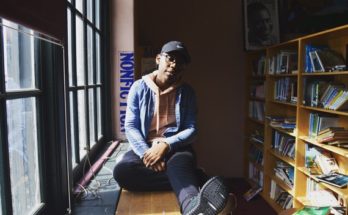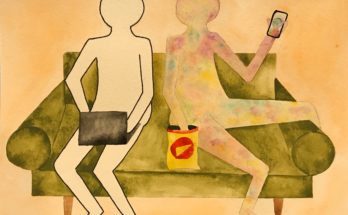Blended Learning from Rula Al-Nasrawi on Vimeo.
On a cold Thursday afternoon, close to 30 students filtered into Jamilah Seifullah’s freshman and sophomore math class at Pathways in Technology Early High School in Brooklyn. Because there was a test scehduled, they sat facing the front of the class — which wouldn’t be unusual in most classrooms. But it is unusual in Seifullah’s class, where students normally sit in groups, working independently on laptops and workbooks and discussing problems Seifullah has posted on the board.
This is blended learning, a curriculum combining both digital and traditional learning techniques within the classroom. The concept is being slowly introduced to schools across the city like Pathways in Technology, also known as P-Tech. The model is part of the iZone, a major pilot program created to fit into the complicated puzzle of public school reform.
Seifullah, a teacher for seven years, is a strong presence in her classroom. She never raises her voice, but speaks with purpose when she needs to make a point. As a student jokingly told her that he forgot to bring a pencil for his test she firmly replied, “You either come prepared or you don’t.” That is how Seifullah runs her class: calmly and efficiently.
She says she likes blended learning because students can work at their own pace, giving her more room to help those who need extra attention. Her class, a combination of geometry, algebra, and trigonometry, uses online programs like Aventa and Flexibook, which allow Seifullah and her students to post and refer back to online lesson plans. She’s one of several P-Tech teachers who have already implemented blended learning into their lessons.
On an average day, her students are usually broken up into three groups based on quiz scores from the previous class. Each group works at its own pace, using both laptops and workbooks to make sure all students are caught up by the end of the lesson.
“The way I’m using it now is as an instructional tool,” Seifullah said. “They’re always working. There’s never a time when they’re not on task.”
Seifullah says that she purposely splits the class up into smaller groups to keep the students focused. There’s plenty of opportunity for distraction, from discreetly listening to music on laptops to playing video games.
Curtis Bonk, an associate professor at the School of Education at Indiana University who has studied blended learning, says that there are a number of different models at the moment, some of them borrowed from the way the business world uses technology.
“The bookend model means that you’ve got online experiences happening before you meet face to face and after,” Bonk said. “The anchor is when you start with face to face and then you move to blended.” Bonk explained that the bookend model is one that is mostly used within corporations to spend less money on travel.
At P-Tech, English teacher Lauren Kilgannon is also using blended learning with her freshmen. On a recent day, backpacks were strewn among the aisles of desks as the teens sit down and begin their daily assignment.
Kilgannon instructed the class on the question of the day—whether social networking should be officially allowed in the school building—and then moved to the back as a student stood up and led the discussion. “This is a technology school and we’re supposed to use technology,” said another student in response to the question.
The class used a Smart Board, an interactive futuristic whiteboard with a stylus used as a marker, and classroom laptops to work on their essays for the day.
Kilgannon has been teaching at P-Tech for two years, and it’s her first teaching job. She has been using the iZone learning program from the beginning.
“The idea is to free up teachers to work with the classroom structure in a different way,” said assistant principal Junghyun Kym. “It allows teachers to plan for their students and know where they’re at.”
Kym says that P-Tech has recently begun using a relatively new program called Achieve 3000, an online reading source. Students take a baseline exam at the beginning to determine their reading level.
“It’s a program within a platform,” Kilgannon said. “They can all read the same article but it can be tailored to their individual reading level.”
Teachers like Kilgannon are able to post and assign nonfiction reading material through this program for students to read and analyze on their own time before coming to class.
Kilgannon’s students were recently required to read various pieces that encompass the American Dream, such as Martin Luther King’s “I Have A Dream Speech.” Paper books are not used in this class; students rely on computer access for most of their assignment.
The question of who decides which programs and software to use is on a case-by-case basis, Bonk said. He explained that while some states, like Michigan and Idaho, require some forms of online learning, sometimes it is up to the school to decide what they will use. Softwares are provided for teachers, and then each teacher is responsible for selecting which programs to use in their class.
Bonk also explained that he as well as others provide tutorials for teachers to learn more about the software before they use them in their classrooms. Most schools don’t offer training, he said, and teachers are generally responsible for learning about the programs independently.
Chris Leung, the technology teacher at P-Tech, doesn’t teach any of his lessons live, yet he shows up to every class. All of his lessons are prerecorded and played for his students in class as they sit in the dimly lit computer lab with the glares of computer screens illuminating their faces. He walks from student to student, checking to make sure each one understands the lessons.
Leung’s Introduction to Technology classes range from a mere seven to a crowded 35 students depending on how students’ schedules are organized. Leung has used this blended learning to try to keep his class, whatever the size, in control. He prerecords short lessons and posts them online for students to watch during class.
“Definitely the bigger class is harder to deal with,” Leung said. “When I record my lessons before, I don’t have to stand in front of class and lecture. I don’t have to repeat myself for the five different classes I teach.”
Leung says he likes the flexibility that blended learning offers.
Advocates of blended learning, like Bonk, believe that all classrooms will ultimately use some form of digital instruction. Part of the reason is economic, he says. Blended learning could save money because it would mean fewer teachers. That possibility has led to come conflict with various teachers unions.
In New Jersey, the state teachers union has begun to push back. Education Association (NJEA), the fear that computers will begin to replace teachers is very real. The teachers union secretary, Marie Blistan, expressed concern in 2012 written testimony to the state’s Joint Committee on the Public Schools.
“You can already see that in Newark, where two operators have opened so-called blended schools that in reality provide 100 percent of their core curriculum content instruction online,” Blistan said in her testimony. “Some of their students will not even be required to report to school at all. We have significant concerns about those kinds of virtual schools and their ability to provide students with a truly thorough and efficient education.”
Even advocates like Bonk concede that since blended learning is still in its infancy, there are still many unresolved issues.
One thing that some P-Tech students recently grappled with what to do when there’s no computer access at home. Normally, the school provides after-school computer access in their labs however, when the school’s labs were temporarily unavailable due to lack of funding, students like Kenneth Theodore, 16, had to do most of their work during school hours.
Theodore, who lives in Brooklyn, lost his computer in 2010. Now he uses the school’s equipment to complete all of his assignments. “I had a computer but I got robbed,” he said quietly as he grabbed a silver MacBook to use in his English Literacy Analysis class.
Although whether or not blended learning works in the long run is still in question, the answer could come from teachers like Seifullah, Kilgannon, and Leung and their students, as they test out the concept one keystroke at a time. “Some of the kids didn’t like it at first,” Kilgannon said. “To what extent should we put the computers aside and have face to face interaction? It’s about finding a balance.”



